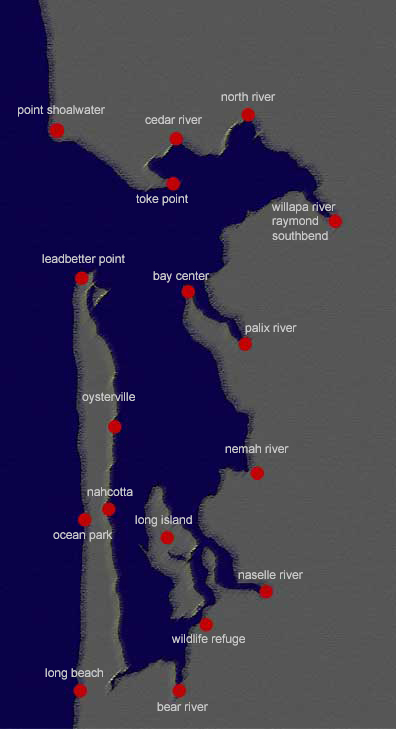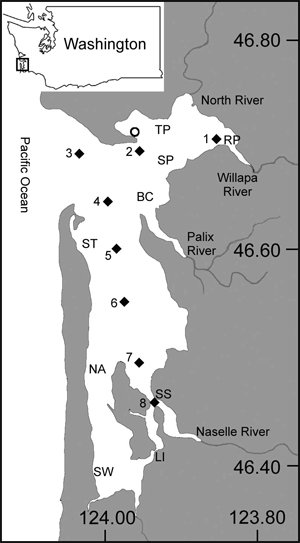
|
A few facts:
Latitude and longitude: 46o40’N, 124o0’W
Area at mean sea level: 24,000 ha
Total area: 35,700 ha
Volume at mean sea level:
Tidal exchange: up to 45% of volume
Annual freshwater input: occurs mostly from October-June
Annual production of oysters: 1,500 metric tons shucked
Area of tideflat occupied by:
- native eelgrass (Zostera marina): 3,424 ha
- introduced eelgrass (Zostera japonica): 2,739 ha
- cultured introduced oysters (Crassostrea gigas): 3,600 ha
- introduced cordgrass (Spartina alterniflora): 1,601 ha in 2000
- high marsh (loss of 30% relative to historic values): 2,484 ha
Area of watershed:
Land use in watershed: predominantly 2nd or 3rd growth timber
|
Willapa Bay produces more oysters than any other estuary in the US (and is reported on signs around the interpretive center to be in the top 5 worldwide). This figure is especially impressive because Willapa Bay is relatively small – about 30 would fit into Chesapeake Bay, for instance. So, what makes Willapa Bay so productive?
- Other places have deteriorated. Chesapeake Bay oyster production has fallen below 5% of its historic levels due to a combination of overexploitation, disease, and water quality problems.
- Willapa Bay has lots of space to grow oysters, given its small size. About half of the area of the bay is tideflat – that means the bay shrinks in size by half during extreme low tides. Oysters are primarily grown on these intertidal flats.
- Oysters have plenty of food to eat in Willapa Bay. Oysters are filter feeders, meaning that they remove small particles as water passes across their gill. The tastiest particles consist of single-celled “plants” (phytoplankton), which (like all plants) require sunlight and nutrients to grow. Where does this phytoplankton come from?
- According to most textbooks, estuaries are very productive because the rivers flowing into them bring nutrients from the land. Indeed, many estuaries are “eutrophic” (nutrient-polluted) because of too many land-derived nutrients from upstream fertilizer use or deforestation. Willapa Bay does seem to benefit from land-derived nutrients from its larger rivers (Willapa River and North River).
- In contrast to most textbooks, organisms in Willapa Bay also benefit from the productivity of the nearshore ocean. Why is the nearshore ocean so productive? Upwelling! Winds blowing from the northwest (those strong winds of sunny summer afternoons) actually cause water to move in a perpendicular direction. As this surface water moves offshore, it leaves behind a “vacuum” that is filled by deep ocean water moving to the surface. Ta-da--- upwelling. Deep ocean water is cold, devoid of life, low in oxygen, but high in nutrients. When brought to the surface, it provides a source of rich nutrient food for phytoplankton growing in the sunlit upper ocean. Upwelling conditions never last forever. Eventually, a front passes through, winds shift, and the surface water is no longer forced offshore. During this “relaxation” phase, phytoplankton and nutrients can be carried into Willapa Bay during the twice-daily tides. No wonder some of the best oyster-growing areas are close to the ocean at the mouth of Willapa Bay.
Willapa Bay is chemically pristine but biologically transformed. There are low levels of industrial pollutants, bacterial loads, and nutrient runoff. That’s the advantage of low human population density. (There are very strong correlations in Puget Sound between population density, impermeable surfaces such as roads and lawns, and impaired water quality.) The shores of Willapa Bay harbor few people and little industry. Sediment runoff from poor logging practices in the early 1900s probably occurred, but the impacts are not well documented. Pesticides and herbicides used by cranberry farmers have been found in runoff but have not been traced to the bay. Two types of chemicals are currently in use to control pest species in the bay: (1) Carbaryl (Sevin) is a potent toxin to arthropods (shrimp, crabs, amphipods, terrestrial insects) and some worms. The target species is ghost (sand) shrimp, a native species that feeds on organic matter attached to sediment. Basically, it eats dirt. The dirt mostly passes right through, but the good stuff on the dirt is useful food. Its feeding activities move a great deal of sediment, which smothers and kills oysters that are grown on the ground. A powdered form of carbaryl is sprayed on several hundred acres of oyster ground each year in July. Its use is scheduled to be phased out within 10 years, but so far there is no clear alternative for removing ghost shrimp. (2) Rodeo (Roundup) and Imazapyr can kill grasses such as Spartina. Spartina is an introduced cordgrass that grows close to the high tide line and is currently expanding in area by 10% annually. It reduces the amount of bare tideflat available for feeding by birds, accumulates sediment, and changes the types of species that live in the sediment. On the whole, Willapa Bay is much more chemically pristine than other estuaries (usually more densely populated by humans). The ability of the bay to continue producing safe and abundant natural resources depends on green development, including complex vegetation next to waterways, working septic and sewage systems, and non-polluting commercial enterprises.
In terms of species composition, Willapa Bay is substantially transformed from a “pristine” state 150 years ago. New and conspicuous species include: Spartina (cordgrass in the upper intertidal zone), Japanese eelgrass (a short form of eelgrass that grows below Spartina), Pacific oysters (the major aquaculture species), Manila clams or steamers (increasingly cultured in Willapa Bay, usually on higher tideflats), oyster drills (snails that eat bivalves and barnacles), Eastern softshell clams (previously much more abundant, and now found occasionally at higher tidal elevations), Green crabs (which panicked people a few years ago but have not materialized as a menace to oysters yet), and sponges and sea squirts (a host of colorful soft-bodied organisms that grow on docks and below low tide). All told, there are some 40 new species in Willapa Bay. Some of these species have simply inserted themselves into the existing milieu, whereas others have forced the natives out (but none have gone extinct that we know of). Because the bay remains chemically pristine, it is still productive and clean, although many of the most productive species are new to the area.
|



